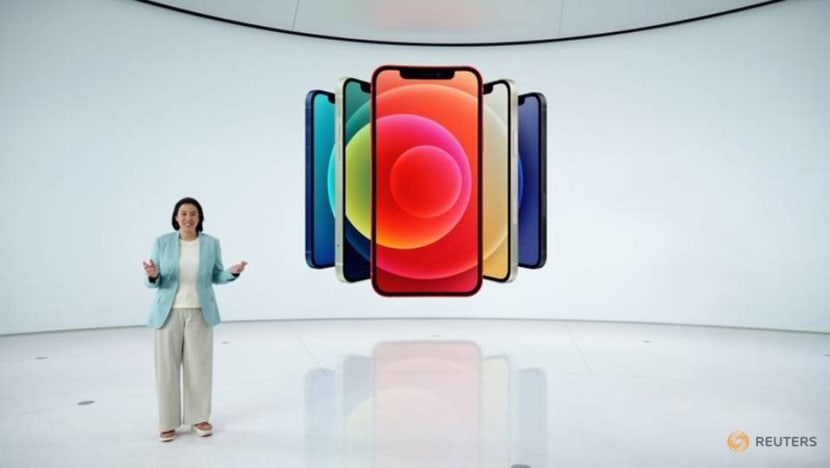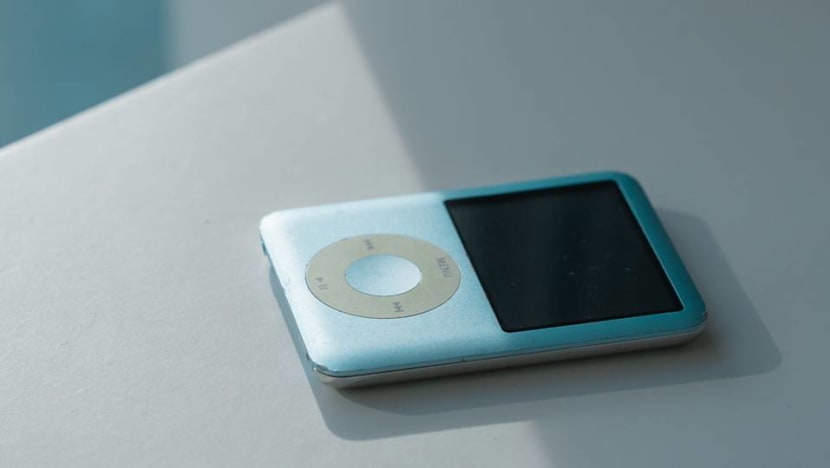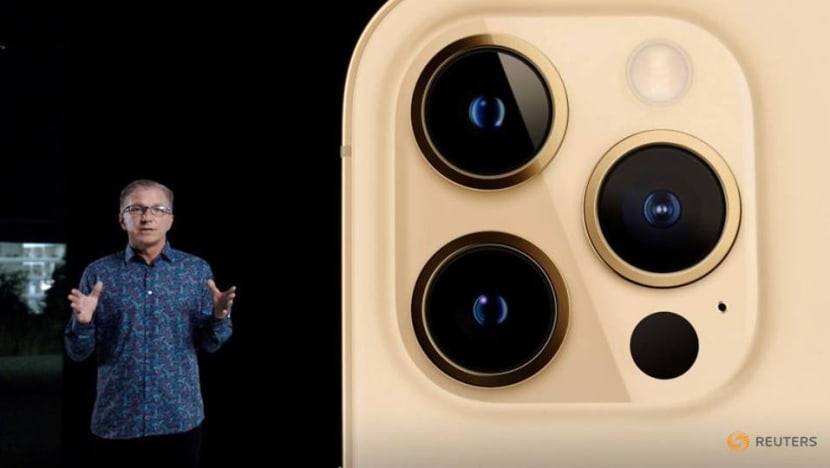commentary Commentary
Commentary: Apple is ahead of the curve with iPhone 12. That may be a problem
With 5G speeds, the use of LIDAR and a ceramic cover, the iPhone 12 has attracted attention but it’s Apple’s shifting strategy that is the real winner, says IMD Business School’s Howard Yu.

Apple's vice president of iPhone Product Marketing Kaiann Drance unveils the all-new iPhone 12 at a special event at Apple Park in Cupertino, California, U.S. in a still image from video released October 13, 2020. Apple Inc./Handout via REUTERS
LAUSANNE, Switzerland: Apple brought all its usual marketing glamour. Tuesday (Oct 13) saw the unveiling of its latest iPhone.
There is the breathless exclamation for new colours. It speaks about the chip speed. Then there’s the less breakable ceramic cover.
And don’t you think a LIDAR (light detection and ranging) is only for those self-driving cars made by Waymo. The Pro line of iPhones also have it now. The Lidar will boost augmented reality (AR).
The real punch was the new 5G wireless speeds. But here lies the problem. Apple, for the first time, is ahead of its foundational technology.
LISTEN: iPhone 12 and Apple’s thinking behind advanced features
READ: Commentary: Does tiny Singapore really need a third Apple store?
DANGER OF BEING TOO EARLY
The late Steve Jobs had warned against the danger of being too early. “Things happen fairly slowly, you know. They do. These waves of technology, you can see them way before they happen, and you just have to choose wisely which ones you’re going to surf.
“If you choose unwisely, then you can waste a lot of energy, but if you choose wisely, it actually unfolds fairly slowly. It takes years.”
Jobs was referring to when he waited for two years for broadband. When it finally arrived, he jumped into the window of opportunity with the iPod.
Countless others went earlier than Apple with their own MP3 players. They all failed miserably.

Before the 2000s, music sharing was possible – on Napster. But it would take hours to download an album.
With connectivity that poor, even the best-designed hardware made for hopelessly sluggish downloading. Jobs was waiting for the inevitable improvement of broadband to materialise.
Contrast that with 2020, Apple has launched an iPhone with a 5G chipset where the networks are far from ready. Around the world, 5G speeds are not necessarily faster than that of 4G.
But Apple CEO Tim Cook has few choices. The shifts to both 3G and 4G were hugely important for spurring people to upgrade their smartphones in the past.
READ: Commentary: iPhone SE is Apple’s cheapest yet but there's more than meets the eye
READ: Commentary: With iPhone 11, Apple is playing catch-up
By the law of large numbers, Apple finds it hard to sustain the same growth rate as it saw in 2014, when the iPhone 6 and 6 Plus were released and became the best-selling iPhone models of all time, selling more than 220 million units worldwide.
Their successors, in comparison, the iPhone 7 and 7Plus, have sold less than 80 million units to date. It’s hard to know how many iPhone 12 Apple could actually sell.
The fundamental problem is, while those faster speeds will help with video-streaming and gaming, it won’t necessarily make a difference in regular web surfing or email checking.
That may cause some consumers to pause before spending the money on a new phone, particularly given the economic uncertainty.

But if you are a shareholder, please don’t sell your Apple shares quite yet. There is one more trick Apple has to get people having the latest iPhone they don’t need.
EVERYTHING IS A SUBSCRIPTION
Starting later this year, Apple One will be available in over 100 countries, including in the US. Apple One includes Apple Music, Apple TV+, Apple Arcade, and iCloud storage, for either individuals or families; Apple Premier adds on Apple News+ and Apple Fitness+.
At this moment, it’s a bit of a stretch to see how Apple One, as a standalone bundle, will get consumers to buy a new iPhone.
But since last year, you can pay for a new iPhone on a monthly basis. In the US, for example, you can get an iPhone 11 and Apple TV+ for US$17 per month. Apple also adjusted their AppleCare+ terms.
You can subscribe monthly, and your AppleCare+ coverage will carry on until you cancel, just as other Apple services like Apple Music.
READ: Commentary: Who will win the streaming war – Apple, Disney or Netflix?
READ: Commentary: How the Apple world is quietly changing
Of course, Apple has the iPhone upgrade programme that bundles a yearly iPhone and AppleCare+, but this shift to allow AppleCare+ to be purchased on its own is another step towards assuming that Apple’s relationship with its customers will be a subscription-based one.
If this sounds complicated, it is. That’s because Apple is running all these different bundles to gather consumer data. It needs behavioural data to calculate the lifetime value of a user.
If I give you a new iPhone, how likely are you going to cancel it in six months? How likely are you going to break it and I will need to replace it for free? If I bundle different services, are you more or less likely to upgrade your phone?
All these questions can only be answered by real world experiments.

To that end, it will be only a matter of time before Apple creates a variant of the iPhone upgrade programme that is simply an all-in Apple subscription. You pay one monthly fee, and get everything Apple has to offer.
Indeed, for an iPhone 12 and beyond, nothing would show that Apple is a services company more than making the iPhone itself a service.
When that happens, make sure you really stock up on Apple shares.
READ: Commentary: Investing in markets? Why future gains lie in tech stocks
THE HOTTEST WAY TO MAKE MONEY
From Netflix to Amazon Prime, from Disney+ to Microsoft 365, the subscription model is king for one reason: Customer adoption. Whenever something turns into a subscription, you will no longer pay a lump sum upfront.
You pay a small monthly fee and then get habituated. After all, when was the last time you cancelled a magazine subscription?
But for a technology company like Apple, subscriptions solve another problem. It helps push the technology toward maturity rather than having it win the consumer over.
READ: Commentary: Cinemas are on life support – and could look vastly different soon
READ: Commentary: Nowhere but up for Netflix after huge Oscar nomination nods
Here is the scenario. Unless there are lots of phones with 5G chipsets, telecom carriers won’t be very eager to roll out 5G vastly. But without a good 5G network, the iPhone 12’s appeal won’t be big.
The subscription model breaks that cycle. You and I won’t mind having a feature we don’t really use. Since the monthly subscription feels cheap, having a new phone with a nice packaging is already enough.
That lowers the barrier to consumption. Which in turn creates this push against telecom providers to plunge ahead with 5G rollout.
Is it a sustainable strategy? We don’t know. But it’s the only viable strategy to keep Apple growing. So Apple is taking it.
Howard Yu is LEGO Professor of Management and Innovation at IMD Business School. This commentary is part of a fortnightly CNA-IMD Business School series on leadership and business issues.












